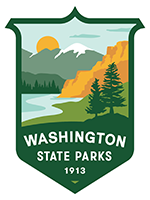We are aware of a text message scam targeting State Parks visitors. It is asking people to share banking information for delinquent payments. This is a scam – we do not ask for payments via text message. Do not click the link, share your information or reply if you receive this text message.
Search results
379 results found
The story of Mount Pilchuck State Park goes deep. The distinctive blocks of light-colored quartz monzonite (a rock like granite but with a smaller proportion of quartz crystals) that a hiker must scramble over to reach the historic fire lookout were once molten magma slowly cooling thousands of feet below the earth’s surface. The mechanisms of plate tectonic subduction elevated the rocks to 5,324 feet above sea level to put Mount Pilchuck’s prominent alpine summit barely 18 miles from salt water at the Snohomish River estuary.
Bottle Beach State Park’s sweeping shoreline provides a window into one of the most important shorebird feeding area on the Pacific Coast. Grays Harbor attracts more than a million birds each spring and up to 20 percent of these migrating birds use the area just off Bottle Beach, peaking in late April and early May. Shorebirds are attracted to this spot because the mudflats just offshore host abundant shrimp-like Corophium amphipods for them to eat. The rich supply of amphipods, up to 55,000 per square meter, is unique along the Pacific Coast.
Doe Island Marine State Park preserves an entire island along the southeastern coastline of Orcas Island in the San Juan Archipelago. It takes its name from the prevalence of deer in the area—nearby place names include Doe Bay, Deer Point and Buck Bay.
A Rocky Island
The San Juan Islands are distinct from most of Puget Sound in that they feature shorelines with exposures of hard bedrock, rather than the bluffs of clay, sand and gravel left by Ice Age glaciers that are predominant on most of Washington’s Salish Sea, the state’s inland saltwater passages.
Sequim Bay State Park hugs the western shore of Sequim Bay, which takes its name from an Indigenous village located near its mouth. The bay is protected at its entrance by two spits that have developed over centuries atop a flat section of underwater land. The spits, which nearly enclose the bay, are made up of glacial debris from the last Ice Age—mostly sand and gravel—that eroded into the water from nearby bluffs and was carried by ocean currents. An 800-foot gap between the spits leads into the seven-mile-long bay.
